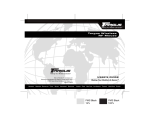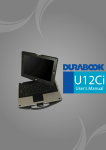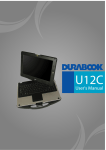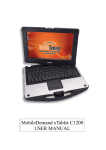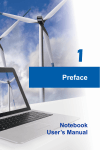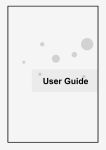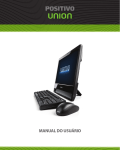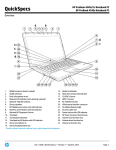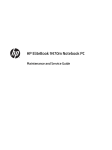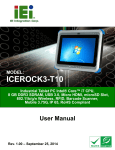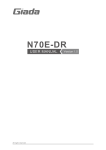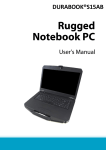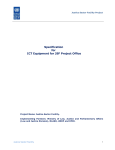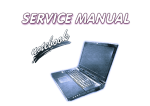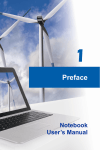Download Manual - EarthWalk
Transcript
Table of Contents COPYRIGHT................................................................................................ 4 REGULATORY STATEMENT................................................................................ 4 Federal Communications Commission Statement .......................................................................................................... 4 Declaration of Conformity ............................................................................................................................................... 4 RF exposure warning........................................................................................................................................................ 5 European Notice ............................................................................................................................................................... 5 R&TTE (CE) MANUAL REGULATORY REQUIREMENT (WLAN - IEEE 802.11b/g).............................................. 5 Canadian Department of Communications..................................................................................................................... 6 Battery Disposal................................................................................................................................................................ 6 CLASS 1 LASER PRODUCT........................................................................................................................................... 6 SAFETY INSTRUCTIONS .................................................................................. 7 BEFORE YOU START ................................................................ 9 PACKAGE CONTENTS ..................................................................................... 9 FEATURES ............................................................................................... 10 COMPONENTS ........................................................................................... 11 Front View ....................................................................................................................................................................... 11 Left View ..........................................................................................................................................................................13 Right View........................................................................................................................................................................13 Back View ........................................................................................................................................................................14 Bottom View.....................................................................................................................................................................15 Status Indicators..............................................................................................................................................................16 GETTING STARTED ................................................................ 17 POWERING UP YOUR NOTEBOOK ..................................................................... 17 Connecting the AC Adapter............................................................................................................................................17 Using Battery Power.......................................................................................................................................................17 INSTALLING THE BATTERY ............................................................................. 18 Charging the Battery.......................................................................................................................................................18 Checking the Battery Level.............................................................................................................................................18 Removing the Battery......................................................................................................................................................19 STARTING YOUR NOTEBOOK .......................................................................... 19 Using the Display Panel.................................................................................................................................................19 Turning On Your Notebook.............................................................................................................................................20 Adjusting the LCD Panel Brightness.............................................................................................................................20 Changing the Display Orientation.................................................................................................................................21 Shutting Down Your Notebook .......................................................................................................................................21 USING THE KEYBOARD ................................................................................. 22 USING THE TOUCH PAD................................................................................ 23 USING THE STYLUS .................................................................................... 24 Calibrate the Screen........................................................................................................................................................24 USING THE QUICK MENU .............................................................................. 26 2 USING THE MEMORY CARDS .......................................................................... 27 Inserting a Memory Card ...............................................................................................................................................27 Removing a Memory Card .............................................................................................................................................27 MAKING CONNECTIONS ........................................................ 28 CONNECTING EXTERNAL DISPLAY DEVICES ......................................................... 28 Connecting a Projector or Display Monitor .................................................................................................................28 Connecting a TV .............................................................................................................................................................28 CONNECTING USB DEVICES .......................................................................... 29 CONNECTING HEADPHONES ........................................................................... 30 CONNECTING EXTERNAL MICROPHONE .............................................................. 30 CONNECTING TO A LOCAL AREA NETWORK (LAN)................................................. 31 CONNECTING AN EXTERNAL SATA HDD............................................................ 31 CONNECTING TO WIRELESS CONNECTIONS ......................................................... 32 Connecting to a Wireless Local Area Network..............................................................................................................32 Connecting to a Bluetooth Device .................................................................................................................................33 POWER MANAGEMENT .......................................................... 35 USING THE POWER PLAN .............................................................................. 35 USING THE POWER SAVING MODE ................................................................... 36 USING THE BIOS SETUP UTILITY.......................................... 37 BIOS SETUP MENU .................................................................................... 37 STARTING THE BIOS SETUP UTILITY ................................................................ 37 NAVIGATING AND ENTERING INFORMATION IN BIOS.............................................. 37 MAIN MENU ............................................................................................. 38 ADVANCED MENU ...................................................................................... 38 BOOT MENU............................................................................................. 39 SECURITY MENU ........................................................................................ 39 SAVE & EXIT MENU .................................................................................... 40 TROUBLESHOOTING.............................................................. 41 SPECIFICATIONS .................................................................. 42 Preface Copyright Copyright© 2013. All rights reserved. No part of this user manual may be transmitted, stored in a retrieval system, or translated into any language or computer language, in any form or by any means, without the prior written permission of the manufacturer. Information is subject to change without prior notice. Regulatory Statement Federal Communications Commission Statement This equipment has been tested and found to comply with the limits for a Class B digital device, pursuant to Part 15 of the FCC Rules. These limits are designed to provide reasonable protection against harmful interference in a residential installation. This equipment generates, uses, and can radiate radio frequency energy and, if not installed and used in accordance with the instructions, may cause harmful interference to radio communications. However, there is no guarantee that interference will not occur in a particular installation. If this equipment does cause harmful interference to radio or television reception, which can be determined by turning the equipment off and on, the user is encouraged to try to correct the interference by one or more of the following measures: Reorient or relocate the receiving antenna. Increase the separation between the equipment and the receiver. Connect the equipment into an outlet on a circuit different from that to which the receiver is connected. Consult the dealer or an experienced radio/TV technician for help. Shielded interconnect cables and shielded AC power cable must be employed with this equipment to insure compliance with the pertinent RF emission limits governing this device. Changes or modifications not expressly approved by the system's manufacturer could void the user's authority to operate the equipment. Declaration of Conformity This device complies with part 15 of the FCC rules. Operation is subject to the following conditions: This device may not cause harmful interference This device must accept any interference received, including interference that may cause undesired operation. 4 Preface RF exposure warning This equipment must be installed and operated in accordance with provided instructions and must not be co-located or operating in conjunction with any other antenna or transmitter. End-users and installers must be provided with antenna installation instructions and transmitter operating conditions for satisfying RF exposure compliance. SAR Value: 0.150 W/kg European Notice Products with the CE Marking comply with both the EMC Directive (89/336/EEC) and the Low Voltage Directive (73/23/EEC) issued by the Commission of the European Community. Compliance with these directives implies conformity to the following European Norms: EN 55022 ( CISPR 22 ) Radio Frequency Interference EN 55024 ( EN61000-4-2, EN61000-4-3, EN61000-4-4, EN61000-4-5, EN61000-4-6, EN61000-4-8,EN61000-4-11, EN61000-3-2, EN61000-3-3 ) Generic Immunity Standard EN 60950-1 ( IEC 60950-1 ) Product Safety R&TTE (CE) MANUAL REGULATORY REQUIREMENT (WLAN - IEEE 802.11b/g) 802.11b Restrictions: European standards dictate maximum radiated transmit power of 100mW EIRP and frequency range 2.400-2.4835GHz. In France, the equipment must be restricted to the 2.4465-2.4835GHz frequency range and must be restricted to indoor use. CE Declaration of Conformity CE! Is herewith confirmed to comply with the requirements set out in the Council Directive on the Approximation of the Laws of the Member States relating to Electromagnetic Compatibility (89/336/EEC), Low-voltage Directive (73/23/EEC) and the Amendment Directive (93/68/EEC), the procedures given in European Council Directive 99/5/EC and 89/3360EEC. The equipment was passed. The test was performed according to the following European standards. EN 300 328 V1.7.1 (2006-05) EN 301 489-1 V.1.4.1 (2005-09) / EN 301 489-17 V.1.2.1 (2002-04) EN 60950-1:2006 5 Preface Canadian Department of Communications This class B digital apparatus meets all requirements of the Canadian Interference-causing Equipment Regulations. Battery Disposal THIS PRODUCT CONTAINS A LITHIUM-ION OR NICKEL-METAL HYDRIDE BATTERY. IT MUST BE DISPOSED OF PROPERLY. CONTACT LOCAL ENVIRONMENTAL AGENCIES FOR INFORMATION ON RECYCLING AND DISPOSAL PLANS IN YOUR AREA. CLASS 1 LASER PRODUCT LASERSCHUTZKLASSE 1 PRODUKT TO EN60825 CAUTION: THIS APPLIANCE CONTAINS A LASER SYSTEM AND IS CLASSIFIED AS A "CLASS 1 LASER PRODUCT.” TO USE THIS MODEL PROPERLY, READ THE INSTRUCTION MANUAL CAREFULLY AND KEEP THIS MANUAL FOR FUTURE REFERENCE. IN CASE OF ANY TROUBLE WITH THIS MODEL, PLEASE CONTACT YOUR NEAREST "AUTHORIZED SERVICE STATION.” TO PREVENT DIRECT EXPOSURE TO THE LASER BEAM, DO NOT TRY TO OPEN THIS ENCLOSURE. ANNEX IV Symbol for the marking of electrical and electronic equipment The symbol indicating separate collection for electrical and electronic equipment consists of the crossed-out wheeled bin, as shown below. The symbol must be printed visibly, legibly and indelibly. 6 Preface Safety Instructions DO NOT block the opening vents provided for ventilation. Blocking these vents may cause the notebook processor to overheat. Always keep strong magnetic or electrical objects away from your notebook. DO NOT use or store your notebook in extreme temperatures. DO NOT place your notebook near fire or other sources of heat. DO NOT expose to dust or corrosive materials. DO NOT tamper the battery. Keep it away from children. Never pick up or hold your notebook by the display. DO NOT expose your notebook to sudden changes in temperature or humidity. Keep your notebook away from air conditioners or heating vents. 7 Preface DO NOT attempt to service your notebook yourself. Any attempt to do so will make the warranty invalid. When servicing, refer to qualified service personnel. For better environmental protection, waste batteries should be collected separately for recycling or special disposal. CAUTION FOR ADAPTER THIS NOTEBOOK IS FOR USE WITH DEDICATED AC ADAPTER. BATTERY SAFETY DANGER OF EXPLOSION IF BATTERY IS INCORRECTLY REPLACED. REPLACE ONLY WITH THE SAME OR EQUIVALENT TYPE RECOMMENDED BY THE MANUFACTURER. DISPOSE OF USED BATTERIES ACCORDING TO THE MANUFACTURER'S INSTRUCTIONS. 8 Before You Start Before You Start Congratulations on your purchase of this notebook. This business notebook is portable and suits a wide-range of user requirements, providing users with maximum computing experience. Before you begin using your notebook, read this chapter to familiarize yourself with the main components installed in the system. Package Contents The following items come with your package. If any of them is damaged or missing, please contact your retailer. Notebook Power adapter Utility DVD Power cord NOTE The pictures are for reference only, actual items may slightly differ. 9 Before You Start Features Intel HM75 platform (Optional HM77 with i-core CPU) Operating system supports Microsoft® Windows 7 12.1” convertible LCD display High capacity hard disk drive Light weight Spill Proof Intel WLAN capability Bluetooth 4.0 connectivity WWAN Express card slot Two battery packs which support 8 hours battery life Optional 1.3 Mega-pixel Webcam Optional M-SATA Solid State Primary Drive (SSD) Optional GobiTM 2000 3G and GPS Optional Finger Print Scanner 10 Before You Start Components Front View No. Item Description 1 Camera Use to take picture, record videos, or video conference. 2 Display panel Provides visual output. 3 Fingerprint scanner Scans fingerprints for biometric identification. 11 Before You Start No. Item Description 4 Brightness control button Press to increase the LCD panel brightness by one level. 5 Brightness control button Press to decrease the LCD panel brightness by one level. 6 SAS button Press to exit Windows and switch to Standby mode. 7 Power button Press to turn your notebook on or off. 8 Quick menu button Press to access the quick menu. 9 LCD direction button Press to rotate the screen orientation. 10 Program button Press to start playback of chosen program. 11 Stealth mode button Press to disable all emitting lights and sound. 12 Status Indicators (Power, Wireless, HDD, Caps Lock, Num lock, Battery) Indicates the corresponding function status. 13 Keyboard Press the keys to input information. 14 Touch pad Use to point, select, drag, or scroll objects on the screen. 15 Touch pad button Press to select objects or display a shortcut menu. 16 Chassis latch Locks the notebook chassis. 17 Handle Use for carrying the notebook around on-the-go. 12 Before You Start Left View No. Item Description 1 USB port Connects USB peripheral devices. 2 Card reader Use to insert memory cards to transfer pictures, music, and data between your notebook and flash compatible devices. The card reader supports SD (Secure Digital), SDHC, Mini-SD (with adapter), MMC (Multi-media card), MMC+, Mini-MMC (with adapter) cards. 3 eSATA/USB Combo port Connects an external hard disc drive using an eSATA cable for faster data transfer, or a USB cable for USB peripheral devices. 4 ExpressCard slot and PC Card slot Use to insert one 34/54 ExpressCard or Type II PC Card. 5 Microphone jack Connects an external microphone. 6 Headphone jack Connects headphones or external speakers. Right View No. Item Description 1 USB port Connects USB peripheral devices. 2 Serial port (RS232) Connects a peripheral device, such as a printer or other device with serial port. 3 USB port Connects USB peripheral devices. 13 Before You Start Back View No. Item Description 1 Kensington lock slot Connects to a Kensington-compatible notebook security lock. 2 VGA port Connects to a display device. (e.g. external monitor, LCD projector). 3 LAN (RJ-45) port Connects to a local area network (LAN) using an Ethernet cable. 4 DC-in jack Connects the power adapter. 14 Before You Start Bottom View No. Item Description 1 Docking station port* Connects the notebook to a docking station. 2 Modular I/O port bays Use for user changeable modular I/O bay to accommodate various devices applications. 3 Cooling vents Use for air convection. Do not cover the cooling vents to protect your notebook from overheating. 4 Stylus Use for accurate control input to the LCD touch panel and digitizer. 5 Battery compartment Contains the battery. 6 Battery latch Locks the battery in place. 7 Hard disk drive (HDD) compartment Contains the hard disk drive. 8 HDD latches Locks the HDD in place. *Docking station port function might not work on your system. Please check with your dealer for more details. 15 Before You Start Status Indicators The status indicators in the upper left corner of the keyboard light up when a particular function of the notebook is active. Each indicator is marked with a symbol. Icon Item 16 Description Power indicator The LED always lights on (blue) when the system is running. When the system is in sleep mode, the LED will blink. WLAN Indicates the status of wireless LAN communication. HDD A blinking HDD LED indicates HDD activity (data is being read or written). Num Lock Lights on when Num Lock is activated. Caps Lock Lights on when Caps Lock is activated. Battery Indicate the battery status: Green: The battery is fully charged or the charging current is 0 for more than 3 minutes with the battery capacity higher than 95%. Blinking green: The system is calibrating the battery. Orange: The battery is being charged. Blinking orange: The battery is being charged but the battery temperature is out of charging range (0~60ºC), the battery is being charged for more than 10 hours, or the charging current is 0 for more than 3 minutes with the battery capacity lower than 85%. Blinking red: The battery power is low (less than 7%). Off: The battery is discharged. Getting Started Getting Started This chapter will guide you on how to use your notebook. Powering Up Your Notebook Your notebook can be powered up using the AC adapter or the Lithium-ion battery. Connecting the AC Adapter The AC adapter powers up your notebook and charges the battery. 1. Connect the AC adapter to the DC-in jack of your notebook. 2. Connect the AC adapter to the power cord. 3. Plug the power cord to an electrical outlet. Using Battery Power 1. Install a charged battery in the battery compartment. 2. Remove the AC adapter (if plugged). Your notebook will automatically use the battery power. NOTE If your notebook is connected to an electrical outlet and the battery is installed, your notebook uses power from the electrical outlet. 17 Getting Started Installing the Battery To install the battery, follow the steps below: 1. Slide and hold the battery latch to the unlock position. 2. Align and insert the battery to the battery compartment. 3. Push completely until the battery locks into place. 4. Release the latch to the lock position to secure the battery. Charging the Battery The Lithium-ion battery is not fully-charged upon purchase. To charge the battery, follow the steps below: 1. Install the battery to your notebook. See procedures above. 2. Connect the AC adapter to the DC-in jack of your notebook. 3. Connect the AC adapter to the power cord. 4. Plug the power cord to an electrical outlet. NOTE The charging time may be longer if you are using your notebook while charging the battery. CAUTION DO NOT charge the battery if the temperature is below 0ºC or higher than 50ºC. Use only the supplied AC adapter. Using other AC adapters may damage the battery or your notebook. Checking the Battery Level The Battery LED flashes red when the battery is nearly depleted. When this happens, save your work and plug the AC adapter to charge the battery or replace the battery with a fully charged one. 18 NOTE Make sure the system has shut down before you change the battery. Getting Started Removing the Battery To remove the battery, follow the steps below: 1. Slide and hold the battery latch to the unlock position. 2. Remove the battery out of the battery compartment. Starting Your Notebook Using the Display Panel • To open the display panel, unlock the chassis latch to open the notebook chassis. Lift the cover lid up to upright position. • To adjust the LCD panel, twist the LCD panel according to your preference. 19 Getting Started • To switch to tablet mode operation, twist the LCD panel 180°, then place it back on the notebook chassis. Lock the chassis latch to secure the LCD panel. Turning On Your Notebook Press the button until the Power LED lights up. Adjusting the LCD Panel Brightness You can adjust the brightness by pressing the Brightness control buttons. To increase the brightness, press the To decrease the brightness, press the button. button. 20 Getting Started Changing the Display Orientation You can rotate the display orientation to suit your preference. Press the clockwise. button repeatedly to rotate the display 90°, 180°, and 270° Shutting Down Your Notebook It is important to properly shut down your notebook to avoid the loss of unsaved data. To shut down your notebook, follow the steps below: 1. Tap Start. 2. Tap Shut down. Wait for your notebook to turn off power completely before removing the power source (if necessary). 21 Getting Started Using the Keyboard No. Keys Description Function keys These function keys are used to perform designated tasks. The tasks for each key may vary from one application to another. [Fn] Press the [Fn] key in combination with other keys to execute a command. [Fn] + F3 Toggles the touch pad to on/off. [Fn] + F4 Switches to suspend mode. [Fn] + F5 Toggles between LCD, External display, or both. [Fn] + F8 Decreases the volume by one level. [Fn] + F9 Increases the volume by one level. [Fn] + F10 Turns on or mutes the volume. 3 Windows key Press to display the Start menu. This action is the same as tapping the Start icon. 4 Numeric keypad Press the Num lock key to activate the numeric keypad. Press the keys on the numeric keypad to enter numbers or operands as you would on a calculator. 5 Application key Press to display an application shortcut menu. This action is the same as right-clicking a mouse button. 1 2 22 Getting Started Using the Touch Pad The touch pad is a cursor-pointing device that provides all the features of a twobutton mouse. Its primary function is to move the cursor around the screen. You can also point, select, or drag items or objects on the screen. Main touchpad Left button Right button Point Slide your finger on the touch pad to point the cursor to an item or object on the screen. Click To left-click, move the cursor to the item or object on the screen, then lightly tap the touch pad or press the left button. To right-click, move the cursor to the item or object on the screen, then press the right button. Double-click To double-click, move the cursor to the item or object on the screen, then tap the touch pad twice or press the left button twice. Drag To drag an item or object, press and hold the left button then slide your finger on the touch pad to move the item or object. Scroll To scroll a page, press and hold the left button then slide your finger on the touch pad to scroll a page. 23 Getting Started Using the Stylus This notebook comes with an integrated stylus for accurate control input to the LCD touch panel and digitizer. You can use the stylus to point, select, or drag items or objects on the screen. To use the stylus, simply remove it from the back of the notebook. Calibrate the Screen To ensure touch accuracy, calibrate the screen. 1. Tap Start > Control Panel. 2. Tap Hardware and Sound > Calibrate the screen for pen or touch input. 24 Getting Started 3. Tap Calibrate. 4. Follow the on-screen instructions to complete screen calibration. 5. After calibration process is complete, tap Yes to save the calibration data. 25 Getting Started Using the Quick Menu Press the button to enter the Quick menu. Tap on the icon to enable the respective function including wireless network, Bluetooth, 3G, GPS, and airplane mode. Tap the icon to set up the media file for the program mode. Select the media file and tap Open. View the battery charge cycles. NOTE 26 Tap YES to activate the selected function. Getting Started Using the Memory Cards Your notebook supports different types of memory cards to provide faster data transfer. Supported types are as follows: SD card SDHC card Mini-SD card (with adapter) MS card (Memory Stick/PRO) MMC card Mini-MMC card (with adapter) Inserting a Memory Card 1. Open the I/O port cover. 2. With the label side up, push the memory card into the memory card slot until it clicks into place. Removing a Memory Card It is important to remove the memory card properly. Improper removal may cause the data in the memory card to be corrupted and your notebook to malfunction. To properly remove the memory card, follow the steps below: 1. Open the I/O port cover. 2. Tap the removable disk icon ( ) on the system tray. 3. Tap Eject Mass Storage Device. The system confirms that the device can be safely removed. 4. Push the memory card to eject it. 5. Pull the card out from the slot. 27 Making Connections Making Connections This chapter will guide you on installing peripheral devices to maximize the use of your notebook. Connecting External Display Devices You can connect your notebook to other display devices, such as a projector, another display monitor, or a TV. Your notebook is equipped with a VGA port which provides both digital and analog video signals. VGA D-sub and HDMI interfaces use digital signals; VGA interface uses analog signals. Connecting a Projector or Display Monitor 1. Open the I/O port cover. 2. Connect one end of a VGA D-sub cable to the VGA port of your notebook. 3. Connect the other end to a projector or display monitor. Connecting a TV 1. 2. 3. 4. Open the I/O port cover. Connect a DVI-HDMI or DVI-VGA cable to the VGA port of your notebook. Connect the cable to the adapter. Connect the other end of the cable to the TV. NOTE The VGA D-sub cable, DVI-HDMI, and DVI-VGA adapters are not included in the package. They are sold separately. 28 Making Connections Connecting USB Devices You can connect your notebook to other USB devices, such as a mouse, keyboard, digital camera, printer, or an external hard disk drive. 1. Open the I/O port cover. 2. Connect one end of a USB cable to the USB port of your notebook. 3. Connect the other end to the USB device (if necessary). NOTE The USB cable is not included in the package. It is sold separately or it may come with your USB device. 29 Making Connections Connecting Headphones You can connect your notebook to a headphone or external speakers. 1. Open the I/O port cover. 2. Plug the audio jack of the headphone or speakers to the Headphone jack of your notebook. NOTE The headphone is not included in the package. It is sold separately. Connecting External Microphone You can connect your notebook to an external microphone. 1. Open the I/O port cover. 2. Plug the audio jack of the microphone to the Microphone jack of your notebook. 30 NOTE The microphone is not included in the package. It is sold separately. Making Connections Connecting to a Local Area Network (LAN) You can connect your notebook to a local area network (LAN) using the RJ-45 LAN port. 1. Open the I/O port cover. 2. Connect one end of an RJ-45 cable to the LAN port of your notebook. 3. Connect the other end to network hub or a wall socket. NOTE The RJ-45 cable is not included in the package. It is sold separately. Connecting an External SATA HDD You can connect your notebook to an external SATA device using the eSATA/USB combo port. 1. Open the I/O port cover. 2. Connect the eSATA cable to the eSATA/USB combo port of your notebook. 31 Making Connections Connecting to Wireless Connections You can connect your notebook to a wireless local area network, WWAN, Bluetooth, or GPS. Before using a wireless built-in device, you need to turn the respective built-in wireless functions on. Connecting to a Wireless Local Area Network Your notebook comes with a WLAN module. A wireless network can be added either when the network is detected or by manually entering the settings information. To connect, follow the steps below: 1. Press the button to open the Quick menu. 2. Tap the WLAN icon ( ) to turn on the wireless network function, and tap YES to activate the WLAN function and exit the Quick menu. ) on the system tray. 3. Tap the wireless network icon ( 4. Available wireless network connections are displayed. Tap the desired wireless network. 5. Tap Connect. Some networks require a network security key or a password. TIPS Check Connect automatically box to automatically connect to this network when it is available. 6. Enter the network security key. 7. Tap OK. 8. After the connection is established, you can see the wireless icon ( Notification area. 32 ) in the Making Connections NOTE Wi-Fi access requires service from a wireless service provider. Contact your service provider for more information. Actual wireless connectivity will depend on system configuration. Please contact your dealer for more information. Connecting to a Bluetooth Device Your notebook can connect and communicate with other Bluetooth-enabled devices. To add a device, follow the steps below: 1. Press the button to open the Quick menu. 2. Tap the Bluetooth icon ( ) to turn on the Bluetooth function, and tap YES to activate the Bluetooth function and exit the Quick menu. 3. Tap the arrow on the system tray to display hidden icons. 4. Tap the Bluetooth icon ( ). 5. Tap Add a Device. The system starts scanning for Bluetooth devices and displays the available devices. NOTE If the device that you want to add does not appear on the screen, please check if the device is turned on and discoverable. 33 Making Connections 6. Tap on a device, then tap Next to continue. 7. Tap Close to complete the pairing connection. NOTE Most Bluetooth-enabled devices need to be paired with your notebook. The PIN you enter on the notebook must be the same PIN to be entered on the other Bluetooth device. Once a partnership has been created, connecting to that device again will no longer require entering the PIN. 34 Power Management Power Management This chapter will guide you on how to manage the system power. Using the Power Plan To improve energy efficiency, you can use the power plan to reduce the amount of power your notebook uses, maximize the performance, or balance the two. 1. Tap Start > Control Panel. 2. Tap System and Security > Power Options. 3. Select a power plan. 4. To adjust the selected power plan settings, tap Change plan settings. 35 Power Management Using the Power Saving Mode When you are not using the notebook, turn off the notebook or set the notebook to enter sleep mode. To set the notebook to enter sleep mode, follow the steps below: 1. Tap Start. 2. Tap Shut down > Sleep. To wake up the notebook from sleep mode, do one of the following: Press the button. Press any key on the keyboard. 36 Using the BIOS Setup Utility Using the BIOS Setup Utility Your notebook has a BIOS setup utility which allows you to configure important system settings, including settings for various optional functions of the notebook. This chapter explains how to use the BIOS setup utility. BIOS Setup Menu The BIOS setup Utility allows you to configure your notebook basic settings. When you turn your notebook on, the system reads this information to initialize the hardware so that it can operate correctly. Use the BIOS setup utility to change your notebook start-up configuration. For example, you can change the security and power management routines of your system. Starting the BIOS Setup Utility You can only enter the BIOS setup utility as the notebook is booting, that is between the time you turn on the notebook and before the Windows interface appears. If your notebook is already on, shut down your notebook completely (power off) and restart it and then press the Delete key to enter the setup utility. Navigating and Entering Information in BIOS Use the following keys to move between fields and to enter information: Function Key Description Selects screen. Moves up/down to select items. Enter +/F1 F2 F3 F4 Confirms the selection and enters the selected menu screen. Changes an option for the selected items. Displays the Help screen. Invokes the previous values. Loads optimized default values. Saves the changes and exits Setup. Press Esc to exit any section. If you wish to exit the BIOS utility Esc without saving changes, go to the main menu, then press Esc. Users are allowed to enter new values to replace the default settings in certain fields, and the rest of the fields are specified by system default parameters and cannot be modified by users. Reverse the attribute of the main options and 37 Using the BIOS Setup Utility press Enter to enter into the submenu. Press Esc to return to the previous configuration page. Main Menu Display the system overview information about BIOS version, CPU features, and total memory size. You can also set the system date and time. Advanced Menu View and configure SATA mode, FAN calibration, battery calibration, wake up event, RF device control, Trusted Computing, Intel Rapid Start Technology, Intel Anti-Theft Technology, and Intel Smart Connect Technology settings. 38 Using the BIOS Setup Utility Boot Menu Configure the boot type and boot, network device BBS, and hard drive BBS sequence. Security Menu Set or change the Administrator and User passwords. 39 Using the BIOS Setup Utility Save & Exit Menu Save or discard the changes, or restore the default values for all setup options before leaving the BIOS Setup Menu. 40 Troubleshooting Troubleshooting This chapter contains a list of common problems that you might experience when using your notebook, and techniques to try and overcome the problem. If you need additional help, contact your retailer. Problems The battery isn’t charging. The screen suddenly turns blank. The notebook cannot connect to Internet. Nothing happens when I press the Power button. The notebook cannot resume from hibernate or standard mode. The notebook does not produce any sound. Solutions • Check if the power adapter is properly connected. • Make sure that the battery is within the recommended charging temperature of -20°C to 50°C. The brightness control is not properly set. Adjust the LCD screen brightness. Your notebook might be in standby or hibernate mode. Press the Power button to wake the system. If using the battery, the battery may be depleted. Replace with a fully charged battery or connect the power adapter to an electrical outlet. Check if the LAN cable is properly connected. If using wireless, check if your location is out of range of the network. Move your notebook closer to the access point. If the network you are connecting to requires a security password, make sure you enter the correct password. Check to make sure the settings configurations are correct. Check if the power adapter is connected to an electrical outlet. If using a battery pack, make sure it has enough power. Otherwise, replace the battery. The battery power level might be too low. Connect the power adapter to an electrical outlet or replace the battery. Audio has been muted. Tap the Speaker icon on the right of your Windows taskbar. When the volume control box appears, uncheck the Mute check box. 41 Specifications Specifications Features Specifications Intel Ivy Bridge Intel CoreTM i5-3427U Type & Speed Processor Major Chipsets System Memory BGA Power Consumption 17W Chipsets Intel HM75 (Optional HM77 with i-core CPU) Type DDR-III 1333 Capacity Two 204-pin DDRIII SODIMM sockets each for 2GB, 4GB (if available) Maximum Memory 16GB (Maximum) LCD 12.1” WXGA (1280x800) TFT, LED backlight Camera Optional 1.3 Megapixel Webcam Touch Screen HDD Point Device 42 Optional resistive type touch panel support palm rejection feature: Optional 12.1” digitizer with digital stylus Non-digitizer touch panel with dummy stylus User removable HDD module without using a tool Support 2.5” SATA HDD Supports an external data rate 6.0 Gbps (Serial-ATA Generation-3) M-SATA I/O Devices Intel Sandy Bridge-ULV-Celeron-Dual core867-1.3GHZ-BGA-2MB Install Method Display Storage Intel Ivy Bridge Intel CoreTM i7-3517U Expansion Card Memory Card Optional M-SATA SSD Hidden Capacitive Touch Pad – PS/2 mouse interface / 2 buttons support Right/Left One Express 34 card slot One SD Card reader slot supports SDHC Specifications Features Specifications Networking devices Communications Wireless networking devices Bluetooth I/O Ports Standard Audio AC Adapter Power Battery Pack 2nd Battery Environment Temperature / Humidity Integrated Gigabit bps Ethernet Support PXE function One Mini Express card slot One is for WLAN (PCI-e only) Intel© WiFi Link 1000 (1x2) with PCI-e Half MiniCard form factor Intel Centrino Wireless N 135 ( WLAN 1x1 b/g/n, Bluetooth 4.0 EDR) Intel Centrino Advanced-N 6235 ( WLAN 2x2 a/b/g/n, BT 4.0 class 1) Support BT 4.0 Class 1 By using WLAN/Bluetooth Combo Mini Express card One USB 3.0 connectors One e-SATA/USB 2.0 combo connector One RJ-45 jack for internal 10/100/1000M bit Ethernet One DC-In jack One 15 pin D-sub VGA port for external monitor/projector Audio jacks (support stereo Mic. Jack) One 84 pin docking connector which supports DC, VGA, LAN and USB (USBx2, VGA, LAN are direct signals from Unit) High Definition Audio Stereo, supports two 1.5W speakers Analog Microphone AC power input:100V-240V,50Hz-60Hz, 65W Output: 19V Compliant with Energy Star 5.0 Standard Li-Ion 6-cell (3S2P, 5200mAH) Smart Battery Pack Optional 2nd Li-Ion 6-cell (3S2P, 5000mAh) Operating Environment Temperature: -20°C ~ 50°C (with AC Adapter) 5°C ~ 50°C (with Battery) Non-operating Environment Temperature: -40°C ~ 70°C Operating Humidity:20% ~ 90%, relative humidity, non-condensing (Depends on temperature) 43 Specifications Specifications MIL-STD-810G, Method 516.6, Procedure IV Drop 4 feet high with 26 drops to 2” plywood over concrete with unit off MIL-STD-810G, Method 514.6, Procedure I, Category 24, Fig. 514.6E-1, Fig. 514.6E-2 (Non-operating) Rugged Standard Vibration ASTM 4169, Truck Transport, 11.5.2 Random test, Assurance Level 2 (Operating) 100C.C.water drop on all C cover area in 2-5 seconds with system operational, for Spill Proof 10 minutes with no effect on system operation or stability. Dimensions 328mm (W) x 277mm (D) x 40.8mm (H) Weight 2.5kg (with standard Battery) Specifications are subject to change without prior notice. Features 44












































